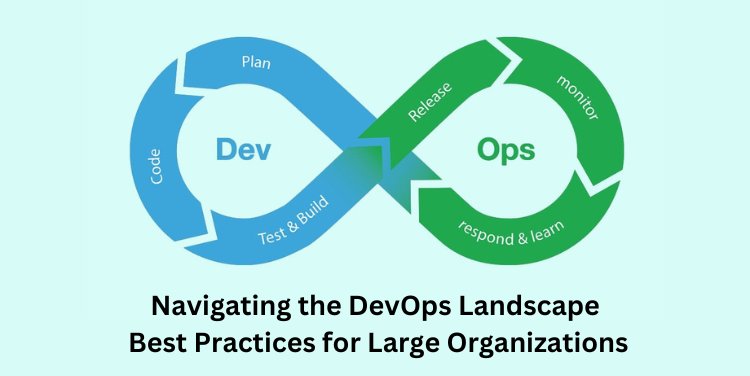Navigating the DevOps Landscape: Best Practices for Large Organizations

In the dynamic world of software development, embracing DevOps practices has become a crucial element for organizations aiming to deliver high-quality products efficiently. For large organizations, implementing DevOps can be both an exciting opportunity and a daunting challenge. This blog explores the best practices for implementing DevOps in large organizations, ensuring a smooth transition towards a more collaborative, agile, and efficient software development environment.
-
Cultural Transformation:
One of the fundamental aspects of successful DevOps implementation is fostering a culture of collaboration and continuous improvement. Large organizations often have diverse teams with different workflows and mindsets. Leaders should champion a cultural shift that encourages communication, transparency, and shared responsibility across development, operations, and other relevant departments.
-
Executive Buy-In and Support:
DevOps implementation requires commitment from the top. Leaders must understand the strategic importance of DevOps and actively support the initiative. Executive sponsorship not only provides the necessary resources but also sets the tone for the rest of the organization to follow suit.
-
Start Small, Scale Gradually:
Instead of attempting a full-scale transformation all at once, it's wise to start with a small, pilot project. This allows teams to learn and adapt to new practices without overwhelming the entire organization. Once success is demonstrated, scale the DevOps practices gradually across different teams and projects.
-
Automation Everywhere:
Automation is at the heart of DevOps, and it plays a crucial role in achieving speed and efficiency. Large organizations should automate repetitive tasks, including build and deployment processes, testing, and infrastructure provisioning. This not only reduces manual errors but also accelerates the development lifecycle.
-
Standardization of Tools and Processes:
Standardizing tools and processes ensures consistency across teams, making collaboration more seamless. Define a set of tools that align with the organization's goals and provide training to teams to foster a unified understanding and usage.
-
Continuous Integration and Continuous Deployment (CI/CD):
Implementing CI/CD pipelines is essential for achieving a continuous and reliable software delivery process. These pipelines automate the building, testing, and deployment of code, allowing teams to release software faster and more frequently.
-
Security as Code:
Security should be an integral part of the development process from the beginning. Embedding security practices into the DevOps pipeline, often referred to as "Security as Code," ensures that security measures are consistently applied and not treated as an afterthought.
-
Feedback Loops and Monitoring:
Establishing robust feedback loops is vital for identifying issues early in the development process. Implement monitoring tools to track the performance of applications and infrastructure in real-time. Analyzing this data provides valuable insights for continuous improvement.
-
Cross-Functional Teams:
Breaking down silos between development, operations, and other departments is a key DevOps principle. Encourage the formation of cross-functional teams that collaborate throughout the entire software development lifecycle, from ideation to production.
-
Continuous Learning:
DevOps is an evolving field, and continuous learning is crucial for staying ahead. Encourage a culture of learning, provide training opportunities, and foster a mindset of experimentation and innovation.
Implementing DevOps in large organizations is a significant undertaking, but the benefits of increased efficiency, faster time-to-market, and improved collaboration are well worth the effort. By prioritizing cultural transformation, gaining executive support, and adopting best practices such as automation, standardization, and continuous improvement, large organizations can successfully navigate the DevOps landscape and position themselves for sustained success in the ever-changing world of software development.
What's Your Reaction?















